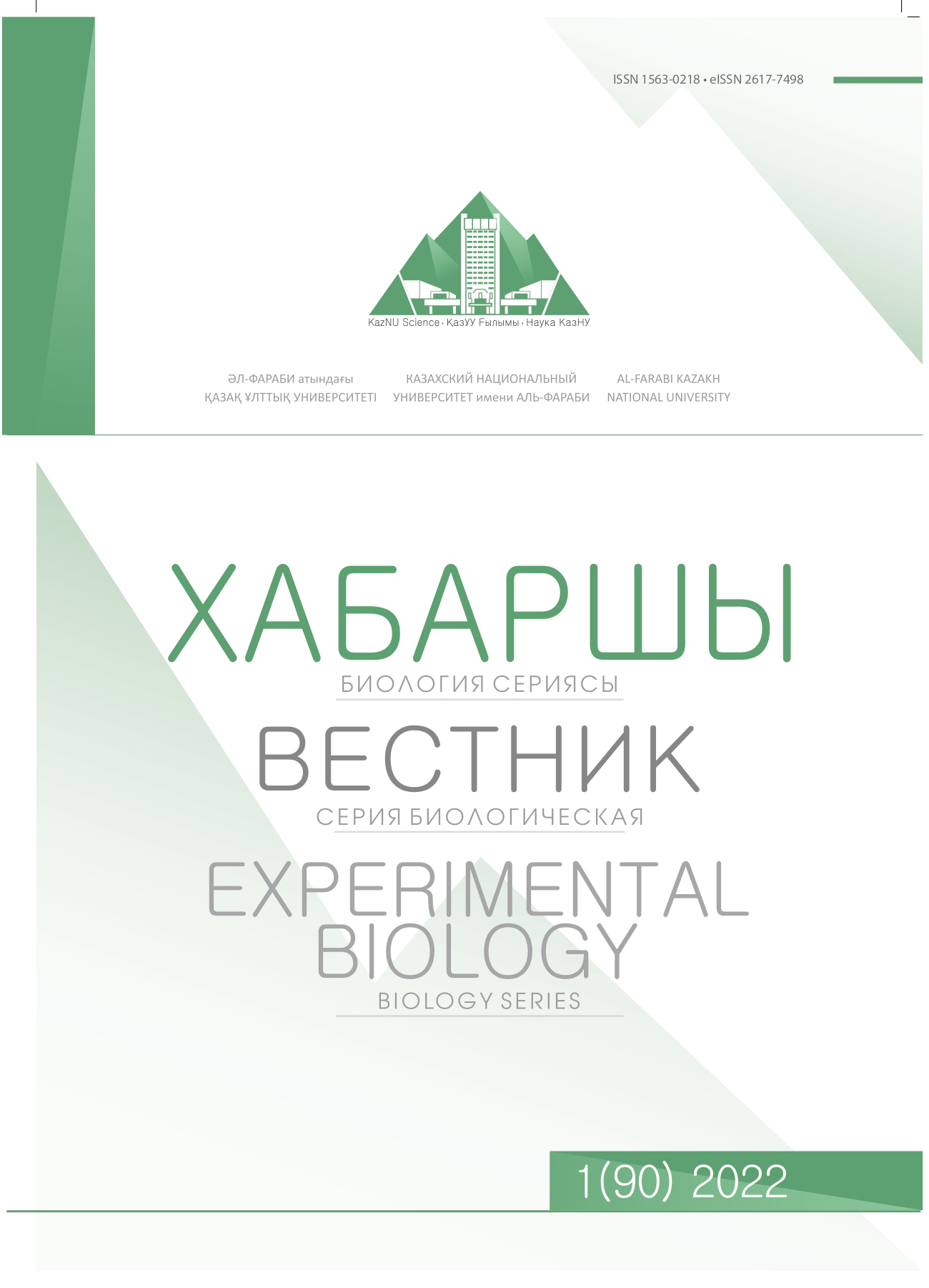МОЛОКОСВЕРТЫВАЮЩАЯ АКТИВНОСТЬ РЕКОМБИНАНТНОГО ВЕРБЛЮЖЬЕГО ХИМОЗИНА
DOI:
https://doi.org/10.26577/eb.2022.v90.i1.04Аннотация
Одним из самых ранних биотехнологических применений ферментов является производство сыра. Высокая специфическая молокосвертывающая активность химозина обеспечивает его преимущество перед другими протеазами в сыроделии. Действие химозина основано на гидролизе связи между аминокислотными остатками Phe105 и Met106 в молекуле κ-казеина, что вызывает дестабилизацию казеиновых мицелл, свертывание молока и разделение его на сгусток и сыворотку. С помощью дрожжевого штамма-продуцента Pichia pastoris GS115/pGAPZαA/ProchymCB получен рекомбинантный химозин двугорбого верблюда Camelus bactrianus. Рекомбинантный химозин был очищен с помощью ионнообменной хроматографии. Изучена молокосвертывающая активность рекомбинантного верблюжьего химозина в отношении кобыльего молока в зависимости от рН и температуры. Установлено, что оптимальным значением, при котором наблюдается максимальная активность рекомбинантного верблюжьего химозина в отношении кобыльего молока pH составляет 4.0, а оптимальной температурой 70°С. Активность рекомбинантного верблюжьего химозина на кобыльем, коровьем и козьем молоке составила 123, 9605 и 4650 ед/мг, соответственно. Показано, что рекомбинантный верблюжий химозин обладает высокой коагуляционной активностью, достаточной для получения творога и сыра. Выход сырного сгустка с 6 л козьего молока составил 936 грамм. Рекомбинантный верблюжий химозин имеет перспективу применения в технологиях переработки коровьего и козьего молока и получения сыра.
Библиографические ссылки
Lambers H., Grammer M.D., Pearse S.J. Veneklaas E.J. (2006) Rood structure and functioning for efficient acquisition of phosphorus: matching morphological and physiological traits. Ann. Bot., vol. 98, pp. 693-713.
Chen YP, Rekha PD, Arun AB, Shen FT, Lai WA, Young CC. (2006) Phosphate solubilizing bacteria from subtropical soil and their tricalcium phosphate solubilizing abilities. Appl Soil Ecol., vol.34, pp.33-41
Yasmin H., Bano A. (2011) Isolation and characterization of phosphate solubilizing bacteria from rhizosphere soil of weeds of khewra salt range and attock. Pakistan Journal of Botany., vol.3, pp. 1663-1668.
Marschner H. (1995) Mineral nutrition of higher plants. London, Academic Press, p.889.
Lambers H., Chapin P.S., Pons T. L. (2008) Plant Physiological Ecology. Second Edition. Springer, p. 604.
Ezawa T., Smith S.E., Smith F.A. (2002) P metobolism and transport in AM fungi. Plant Soil, vol. 244, pp. 22-230.
Menezes-Blackburn D., Giles C., Darch T., George TS, Blackwell M., Stutter M., Shand Ch, Lumsdon D, Cooper P., Wendler R., Brown L., Almeida DS, Wearing C., Zhang H., Haygarth PM (2018) Opportunities for mobilizing recalcitrant phospho- rus from agricultural soils: a review. Plant Soil 427:5–16. DOI 10.1007/s11104-017-3362-2
Dunaitsev A. (2010) Isolation of phosphate-mobilizing microorganisms and the study of the possibility of their Buse in industry and agriculture. Author. diss. Cand. Biol. Sciences: 03.02. 03.01.06, Obolensk: Science, p 29.
Thakaria D., Talukudarl N.C., Goswamil C., Hazarical S., Boro R.C., Khan M.R. (2004) Characterization and screening of bacteria from rhizosphere of rice grown in acidic soils of Assum. Curr. Sci., vol. 86, pp.978-985.
Mehrvarz S., Chaichi M.R., Alikhani H. A. (2008) Effects of Phosphate Solubilizing Microorganisms fnd Phosphorus Chemical Fertuliezeron Yield Compenents of Barely (Hordeum vulgare L.). American-Eurasian J. Agric. & Environ.Sci., vol. 3(6), pp. 823-828.
H.J.Son (2006) Solubilization of inorganic phosphates by a novel salt- and pH- tolerant Pantoea agglomerans R-42 isolated from soybean rhizosphere. Bioresource Technology., vol. 97, pp.204-210.
Bais H.P., Perry L.G. (2006) The role of root exudatees in rhizosphere interactions with plants and other organisms. Annual Review of Plant Biology, vol.57, pp. 233-266.
Fankem Henri., Duble A., John K. (2008) Solibilization of inorganic phosphates and plant growth promoting by strains of Pseudomonas fluorescens isolated from acidic soils of Cameroon. African Journal of Microbiology Research, vol. 2, pp. 171-178.
Sharifi R.S, Khavazi K. (2011) Effects of seed priming with Plant Growth Promoting Rhizobacteria (PGPR) on yield and yield attribute of maize (Zea mays L.) hybrids. J Food Agric. Environ., vol. 9, pp. 496-500.
Cruz-González X, Laza-Pérez N, Mateos PF, Rivas R. (2017) Analysis and effect of the use of biofertilizers on Trifolium rubens L., a preferential attention species in Castile and Leon, Spain, with the aim of increasing the plant conservation status. AIMS Microbiol., vol. 3 (4), pp. 733- 746.
Aeron A., Khare E., Kumar C., Vijay J., Meena S., Mohammed S., Aziz A. (2019) Revisiting the plant growth-promoting rhizobacteria: Lessons from the past and objectives for the future. Arch. Microbiol. vol. 202, pp. 665–676
Sattari S., Bouwman A., Giller K., van Ittersum M. (2012) Residual soil phosphorus as the missing piece in the global phosphorus crisis puzzle. Proc Natl Acad Sci, vol. 109, pp. 6348–6353
Pikovskaya, R.I. (1948) Mobilization of phosphorus in soil in connection with the vital activity of some microbial species. Mikrobiologiya, vol. 17, pp. 362 – 370.
Zviagintsev D.G. (1991) Metody pochvennoi mikrobiologii I biohimii [methods of soil microbiology and biochemistry]. M, Izdatelstvo MGU, pp. 59 – 75.
20.Nautiyal C.S (1999) An efficient microbiological growth medium for screening phosphate-solubilizing microorgan- isms. FEMS Microbiology Letters, vol.170, pp. 265–270.
Clarridge III J. E. (2004) Impact of 16S rRNA Gene Sequence Analysis for Identification of Bacteria on Clinical Microbi- ology and Infectious Diseases. Clinical Microbiology Reviews, vol.17, pp. 840–862.
Janda J., Abbott S. (2007) 16S rRNA gene sequencing for bacterial identification in the diagnostic laboratory: Pluses, perils, and pitfalls. J. Clin. Microbiol. Vol. 45, pp.2761–2764.
Koubek J. (2012) Whole – cell MALDI – TOF: Rapid screening method in environmental microbiology. International biodeterioration biodegradation. Journal of Environmental Microbiology, vol.69, pp. 82-86.
Magallon-Servín P., Antoun H., Taktek S., Bashan Y., De-Bashan L. (2020) The maize mycorrhizosphere as a source for isolation of arbuscular mycorrhizae-compatible phosphate rock-solubilizing bacteria. Plant Soil. Vol. 451, pp.169–186
Adelowo E.F., Agele S. (2016) Spectrophotometric analysis of phosphate concentration in agricultural soil semples and water samples using molybdenum blue method. Brasian Journal of Biological Science, vol. 12, pp234-239.
Mehta, S., Nautiyal, C.S., (2001) An effecient method for qualitative screening of phosphate-solubilizing bacteria. Curr. Microbiol. Vol.43 (1), pp.51-56.




